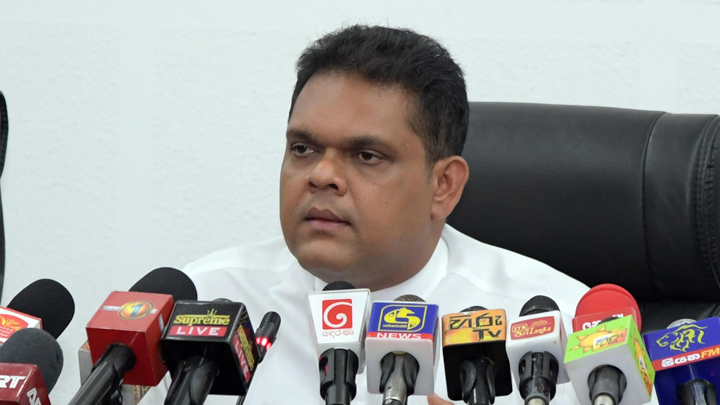General
Sri Lanka holding second meeting with bilateral creditors: Minister


ECONOMYNEXT – The Federal Reserve hiked its main policy rate 75 basis points to target a 3.75/4.0 percent and said the policy rate may peak at higher level than indicated in September.
The Fed is simultaneously withdrawing excess liquidity from money markets in another tightening measure.
The Fed and several other reserve currency central banks printed large volumes of money in 2020 to accommodate a real economic shock from the Covid-19 pandemic and fired worst commodity and inflation bubble since the Greenspan-Bernanke bubble that burst in 2008.
The Fed has a confused mandate to create jobs as well as control inflation leading to policy errors and rising food prices, hurting the poor across the world.
“The Fed’s monetary policy actions are guided by our mandate to promote maximum employment and stable prices for the American people,” Powell told reporters after raising rates.
“My colleagues and I are acutely aware that high inflation imposes significant hardship as it erodes purchasing power, especially for those least able to meet the higher costs of essentials like food, housing, and transportation.
“We are highly attentive to the risks that high inflation poses to both sides of our mandate, and we are strongly committed to returning inflation to our 2 percent objective.”
Powell artfully blamed Putin for adding to inflation – a claim often made by US politicians – but raised policy rates anyway.
“And the recent inflation data have again come in higher than expected. Price pressures remain evident across a broad range of goods and services,” Powell said.
“Russia’s war against Ukraine has boosted prices for energy and food and has created additional upward pressure on inflation.”
The US has previously blamed an Arab oil embargo and OPEC for inflation as the Fed printed money and destroyed the last remnants of the gold standard in 1971.
Western central bankers have come up with various non-monetary excuse or scapegoats to blame inflation on and escape censure and accountability.
Powell let inflation get out of control by delaying monetary tightening claiming that inflation in 2021 was ‘transitory’. Supply chain bottle necks’ were also blamed.
He later said the word ‘transitory’ should be retired after facing a barrage of questions from a US lawmaker who was an ex-banker.
Related
Fed to end injections sooner, ‘retire’ transitory, Powell says as inflation rages in Sri Lanka
US inflation will overshoot target, Powell delusional: Hanke
Another frequent scapegoat of Western Mercantilists is the ultimate victim of central bank policy, the general public, who are blamed for having ‘inflation expectations’. In the October statement no such blame was placed.
“Despite elevated inflation, longer-term inflation expectations appear to remain well anchored, as reflected in a broad range of surveys of households, businesses, and forecasters, as well as measures from financial markets,” Powell said.
“But that is not grounds for complacency; the longer the current bout of high inflation continues, the greater the chance that expectations of higher inflation will become entrenched.”
When central banks – the only agencies that has control of money supply and therefor inflation – pushes up inflation, there is usually hunger, strikes, social unrest and incumbent governments get booted out.
There are signs that Fed policy is working with food prices starting to come down from earlier peaks as the dollar strengthens.
Sri Lanka has also benefited with oil and some food commodity prices coming down. Energy prices which have fallen from earlier peaks are still elevated.
Related
Sri Lanka’s Ceylon Tea prices fall for the third week
However Sri Lanka’s export prices such as tea which have spiked recently in dollar terms could also fall.
The Full FOMC statement is reproduced below
Federal Reserve issues FOMC statement
Recent indicators point to modest growth in spending and production. Job gains have been robust in recent months, and the unemployment rate has remained low. Inflation remains elevated, reflecting supply and demand imbalances related to the pandemic, higher food and energy prices, and broader price pressures.
Russia’s war against Ukraine is causing tremendous human and economic hardship. The war and related events are creating additional upward pressure on inflation and are weighing on global economic activity. The Committee is highly attentive to inflation risks.
The Committee seeks to achieve maximum employment and inflation at the rate of 2 percent over the longer run. In support of these goals, the Committee decided to raise the target range for the federal funds rate to 3-3/4 to 4 percent. The Committee anticipates that ongoing increases in the target range will be appropriate in order to attain a stance of monetary policy that is sufficiently restrictive to return inflation to 2 percent over time. In determining the pace of future increases in the target range, the Committee will take into account the cumulative tightening of monetary policy, the lags with which monetary policy affects economic activity and inflation, and economic and financial developments. In addition, the Committee will continue reducing its holdings of Treasury securities and agency debt and agency mortgage-backed securities, as described in the Plans for Reducing the Size of the Federal Reserve’s Balance Sheet that were issued in May. The Committee is strongly committed to returning inflation to its 2 percent objective.
In assessing the appropriate stance of monetary policy, the Committee will continue to monitor the implications of incoming information for the economic outlook. The Committee would be prepared to adjust the stance of monetary policy as appropriate if risks emerge that could impede the attainment of the Committee’s goals. The Committee’s assessments will take into account a wide range of information, including readings on public health, labor market conditions, inflation pressures and inflation expectations, and financial and international developments.
Voting for the monetary policy action were Jerome H. Powell, Chair; John C. Williams, Vice Chair; Michael S. Barr; Michelle W. Bowman; Lael Brainard; James Bullard; Susan M. Collins; Lisa D. Cook; Esther L. George; Philip N. Jefferson; Loretta J. Mester; and Christopher J. Waller.









